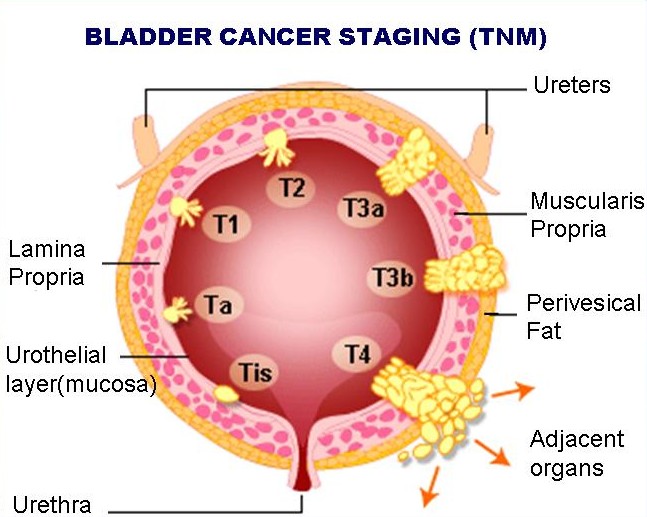Health Tools
Hygiene
Naturopathy
Mental health
More Articles
Bladder Cancer Stages And Grade

Grade and Stages
The latest TNM system for staging bladder cancer was developed by the UICC in 1997 .According to recent consensus
decisions of the American Joint Committee on Cancer (AJCC), the stage groupings
of bladder cancers are as follows:
Individuals with Grade 1, Stage 0 tumors usually do not need any additional workup for staging, because there is
little risk of metastasis. On the other hand, people with more advanced cancers, like Grade 2 or Stage 2 tumors,
need a routine staging evaluation. Basic blood work, a chest X-ray, lower body imaging using computed tomography
(CT scan) or magnetic resonance imaging, and a bone scan should all be part of this evaluation.
- Ta (papillary, noninvasive carcinoma)
"Ta" tumors are papillary (wart-like) in nature. They often look like pink cabbages, and they may be present in groups.
Ta tumors are confined to the inner surface of the bladder wall and are distinguished from T1 tumors because they
have not broken through the basement (supporting) membrane.
- TIS (carcinoma in situ; flat, pre-invasive tumor)
If the invasion process is still in its early stages and can only be observed under a microscope, the
tumor is categorized as T3a. The tumor is categorized as T3b, nevertheless, if it is clearly massed on
the outer bladder tissue. Unlike papillary tumors,
TIS tumors are flat.TIS tumors include pre-invasive (basement membrane-confined) malignant cells. TIS cells
show anaplastic (lacking cellular differentiation, the defining properties of a cell) when found in the urine
by Pap staining. TIS may resemble cystitis without hematuria in middle-aged men. Accurate diagnosis depends
upon biopsy of the mucosa in any patients with unexplained cystitis or sterile pyuria (no microorganisms are
present but there is "pus-like" matter in the urine).
- T1 (tumor invasion of connective tissue)
During clinical inspection, T1 tumors often look like Ta tumors. These cancers may appear as an
isolated mass, or they may be present in groups. But the distinctive feature of the T1 tumor is
that—although it has broken through the basement membrane into the connective tissue of the
bladder-lining mucous membrane (lamina propria)—the stalk of the tumor has not
invaded the muscle below. Some physicians believe that T1 tumors should not be considered
"superficial TCC," because they have the potential to be invasive and to progress. T1 tumors have a progression
rate of roughly 30%. In T1 lesions of Grade 3 or Grade 4, nearly half of all tumors progress.
- T2 (tumor invasion of muscle)
T2 tumors are characterized by the invasion of the muscle surrounding the bladder. T2a tumors that exclusively affect
the inner half of "superficial" muscle and have well-differentiated tumor cells may not have reached the lymphatic
system. The patient's prognosis is often worse if the tumor (T2b tumor) has reached the outside half of the "deep"
muscle and the cells are not well differentiated.
- T3 (tumor invasion of perivesical tissue)
When a tumor outside of the abdominal cavity has penetrated the muscle surrounding it and started to
infiltrate the perivesical tissue (fatty tissue surrounding the bladder) or peritoneum (membrane lining
the abdominal cavity), the bladder, it is classified as a T3 tumor. If the process of invasion has just begun and only can be seen by microscopy, then the tumor is
classified as T3a. However, if the tumor is visibly massed on the outer bladder tissue, then it is classified
as T3b.
- T4 (tumor invasion of surrounding organs)
If a tumor has progressed to invade nearby organs—such as the prostate (a male gland that surrounds the bladder neck
and urethra and adds a secretion to the semen), uterus (womb), vagina (female reproductive canal), or walls of the
abdomen or pelvis (hip bone)—it is classified as T4. T4 tumors are, by and large, inoperable, meaning they can/should
not be surgically removed. They might result in uncomfortable symptoms, hematuria, frequent urination, and insomnia.
Additionally, the bladder's necrotic (dead) tissue frequently contracts an infection. Patients with T4 tumors may
undergo surgery not as a kind of treatment but as a way to lessen their pain.
Previous
Top